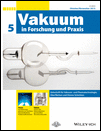Verlust der Heliumdichtheit geschweißter Aluminiumbauteile
Dichtheitsnachweis mit dem UST-Verfahren
Abstract
deVakuum im Fusionsreaktor erfüllt zwei Aufgaben. Zum einen ist es erforderlich, um das Fusionsplasma zu betreiben, zum anderen vermindert es als Isoliervakuum den Wärmeeintrag auf die mit flüssigem Helium gekühlten supraleitfähigen Spulen. Letzteres ist besonders gefährdet, wenn es durch Verlust der Supraleitfähigkeit und einhergehenden Temperaturanstieg zu einem massiven Druckanstieg im Heliumkühlsystem kommt. Daher muss vor Inbetriebnahme des magnetischen Käfigs die Helium-Dichtheit der Kühlkomponenten unter extremen Bedingungen nachgewiesen werden. Der vorliegende Beitrag vergleicht die dabei mit zwei verschiedenen Lecksuchverfahren gewonnen Ergebnisse und stellt die Vorzüge des für diesen Einsatz entwickelten Ultra-Schnüffler-Testgas-(UST-) Verfahrens dar.
Abstract
enLoss of Helium tightness of aluminium vacuum components — Vacuum leak search with the UST-procedure
Vacuum in nuclear fusion reactors is used within the plasma vessel and the cryostat — the latter in order to isolate the superconducting magnetic coils from heat transfer through the gas atmosphere. In case of loss of superconductivity the resulting temperature rise causes an enormous increase of Helium pressure in the cryostat endangers the isolating vacuum. Therefore prior to installation all parts of the cryostat undergo thorough leak-checking procedures. This paper compares the results of two leak detection methods and presents the advantages of the Utra-Schnüffler-Testgas-(UST-) technique developed for this purpose.




